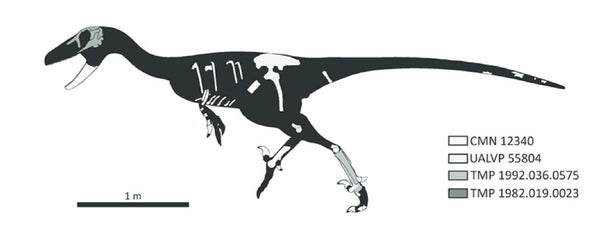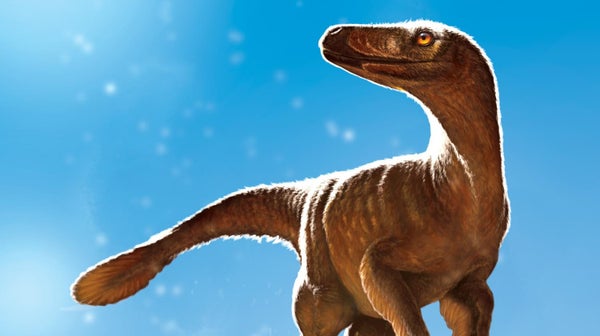This article was published in Scientific American’s former blog network and reflects the views of the author, not necessarily those of Scientific American
Sometimes paleontologists look at dinosaur bones in the ground and immediately know they've found a new species. An unusual flange of bone, a part of a skull, or other piece can give away something never seen before. But, just as often, new dinosaur species remain hidden in museum collections, waiting for new discoveries to put them into context and new eyes to detect their presence. And there are times when new finds and previously-collected fossils come together to reveal a new dinosaur. That's what happened with Latenivenatrix.
In 2014, paleontology graduate student Aaron van der Reest found the hips of a theropod dinosaur in Alberta's Dinosaur Provincial Park. This was already a significant find. The park is famous for its large dinosaur skeletons and bonebeds, but smaller species are rare. But when van der Reest and advisor Phil Currie set about comparing the hip bones to other theropod fossils, they not only found that this dinosaur was new, but that an old dinosaur name might be valid again.
The taxonomic tale is a little complicated. It involves a dinosaur that's everywhere and nowhere. For decades, paleontologists have been assigning various bones and teeth from Alaska to the Four Corners to a raptor-like dinosaur called Troodon. It's unusual for one dinosaur to have such a wide range, however, and in recent years some of these "Troodon" fossils have turned out to be new species - like Talos from southern Utah.
Latenivenatrix differs enough from previously-identified "Troodon" material to be something new. Aside from anatomical particulars, the dinosaur is substantially larger than its relatives - nearly twelve feet long. And the analysis of this fossil changed something else.
The name "Troodon" was based on an isolated tooth that isn't diagnostic. That makes the name basically useless, as other experts had pointed out before. And because there's a second, smaller relative of Latenivenatrix in the same formation, van der Reest and Currie suggest returning to a name based on bones that had been out of fashion since the 80s - Stenonychosaurus.
There's still some untangling to do. Even though "Troodon" isn't a useful name now, it might be if someone eventually finds a unique skeleton that matches that original tooth. And Troodontidae is still used as the name for this dinosaur family even if the name "Troodon" is on extended suspension. Still, the new study marks a turning point for understanding these rare theropods. In one study, van der Reest and Currie named Latenivenatrix, sunk "Troodon", and resurrected Stenonychosaurus, underscoring the point that we still have a lot to learn about this peculiar family of dinosaurs.

A composite reconstruction of Latenivenatrix. Credit: van der Reest and Currie 2017
Fossil Facts
On supporting science journalism
If you're enjoying this article, consider supporting our award-winning journalism by subscribing. By purchasing a subscription you are helping to ensure the future of impactful stories about the discoveries and ideas shaping our world today.
Name: Latenivenatrix mcmasterae
Meaning: Latenivenatrix means "hiding hunter", while mcmasterae is in honor of van der Reest's late mother.
Age: Cretaceous, around 75 million years old.
Where in the world?: Dinosaur Provincial Park, Canada.
What sort of organism?: An troodontid dinosaur.
How much of the organism’s is known?: A partial skeleton and additional specimens of the skull, hips, and limbs..
Reference:
van der Reest, A., Currie, P. 2017. Troodontids (Theropoda) from the Dinosaur Park Formation, Alberta, with a description of a unique new taxon: implications for deinonychosaur diversity in North America. Canadian Journal of Earth Sciences. doi: 10.1139/cjes-2017-0031
Previous Paleo Profiles:
The Light-Footed Lizard The Maoming Cat Knight’s Egyptian Bat The La Luna Snake The Rio do Rasto Tooth Bob Weir's Otter Egypt's Canine Beast The Vastan Mine Tapir Pangu's Wing The Dawn Megamouth The Genga Lizard The Micro Lion The Mystery Titanosaur The Echo Hunter The Lo Hueco Titan The Three-Branched Cicada The Monster of Minden The Pig-Footed Bandicoot Hayden's Rattlesnake Demon The Evasive Ostrich Seer The Paradoxical Mega Shark The Tiny Beardogs The Armored Fish King North America's Pangolin The Invisible-Tusked Elephant The Mud Dragon The Spike-Toothed Salmon The Dream Coast Crocodile Buriol's Robber Ozimek's Flyer The Northern Naustoceratopsian The High Arctic Flyer The Tomatillo From the End of the World The Short-Faced Hyena The Mighty Traveler from Egg Mountain Keilhau's Ichthyosaur Mexico's Ancient Horned Face Mauricio Fernández's Plesiosaur New Zealand's Giant Dawn Penguin The Orange Sea Lion Mongolia's Ginkgo Cousin The Geni River Frog Isabel Berry's Dinosaur The Whale Caiman The Moab Lizard Yang Zhongjian's Lizard The Little Anubis The Shuangbai Lizard The Wyvern Dinosaur The "Need Helmet" Dinosaur The Jianianhua Dragon The Liaoning Hunter The Dalian Lizard Crompton's Aleodon Jenkins' Amphibian Serpent From the Chinle The Large Ancestor Lizard The Crown Tooth Currie's Alberta Hunter The Elephant Bird Mimic The Crested Thief
